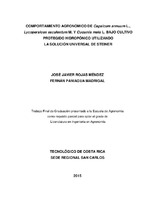Comportamiento agronómico de Capsicum annuum L., Lycopersicon esculentum M. y Cucumis melo L. bajo cultivo protegido hidropónico utilizando la solución universal de Steiner
Fecha
2015Autor
Rojas-Méndez, Javier
Paniagua-Madrigal, Fernán
Metadatos
Mostrar el registro completo del ítemResumen
Three horticultural crops were grown under greenhouse and hydroponic conditions using Steiner‟s Universal Nutrient Solution (1984) in the humid tropic San Carlos area, Costa Rica, on November 2013 and May 2014. Using the cultivars Nathalie and 4212 of sweet pepper (Capsicum annuum L.), JR and Lyro of tomato (Lycopersicon esculentum M.), Sol Real and Acclaim of cantaloupe melon (Cucumis melo L.), two treatments per crop were established which corresponded to each cultivar, a completely randomized design with nested array was used having three replications per treatment. Growth, yield and nutrient uptake were measured. Growth expressed as total dry weight per plant of sweet pepper was 744,1g/plant in cv Nathalie and 809,5g/plant in cv 4212, both cultivars reached 50% in the fruits, for tomato crop was reported 703,4g/plant in cv JR, less than cv Lyro which obtained 1180,5g/plant, representing 53,1% y 69,3% of the harvest respectively; for cantaloupe melon 190,8g/plant was reported in cv Sol Real and 159,9g/plant in cv Acclaim. Production in sweet pepper was 4,69kg/plant in cv Nathalie and 4,70kg/plant in cv 4212, for tomato crop the yield was 8,5kg/plant in cv JR and 10,9kg/plant in cv Lyro, no marketable fruits were obtained in both cultivars of cantaloupe melon. Macronutrient uptake order was K>N>Ca>P>Mg in sweet pepper and tomato crops whereas in cantaloupe melon was K>N>Ca>Mg>P, the cv 4212 reported higher uptake of macronutrients regarding to cv Nathalie, the cv Lyro absorbed more quantity of N, Mg, K y P in contrast to the cv JR which obtained greater Ca content, and the cv Sol Real reported more uptake of macronutrients than the cv Acclaim. Micronutrient uptake order was different for each crop studied; in sweet pepper the Mn and Zn were the most absorbed while in tomato were Zn and Fe; in cantaloupe melon the Mn and Fe were the most demanded micronutrients. The use of a limited nutrition regarding to the Steiner‟s Universal Nutrient Solution (1984) represented a different performance in the three horticultural crops under this study.
Descripción
Proyecto de graduación (Licenciatura en Ingeniería en Agronomía) Instituto Tecnológico de Costa Rica, Escuela de Agronomía, 2015


